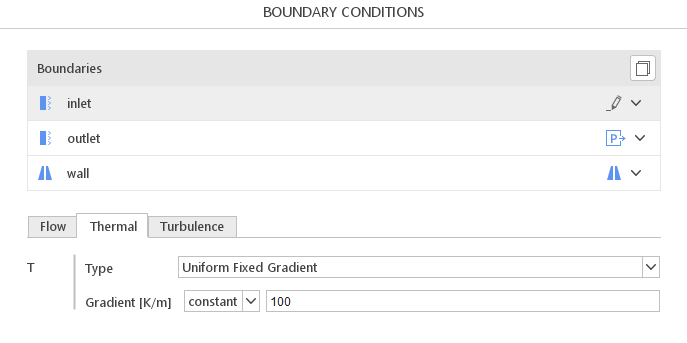Uniform Fixed Gradient - Boundary Condition Description
Uniform Fixed Gradient boundary condition is a derivative of Fixed Gradient. It sets the gradient to the uniform value (throughout the entire boundary) as a constant value or as a function of time. The Uniform Fixed Gradient can be applied to all variable types (scalars, vectors).
Mathematically, the Uniform Fixed Gradient can be described as:
- \(\phi\) is the scalar or vector field
- \(\nabla \phi\) is the gradient of the field
- \(\mathbf{n}\) is the normal vector to the boundary
Uniform Fixed Gradient - Boundary Condition Understanding Uniform Fixed Gradient
Uniform Fixed Gradient works in the same way as Fixed Gradient. However, the key distinction is its ability to define time-dependent values at the boundary. The Uniform Fixed Gradient enables the definition of time-dependent profiles for various dependent variables, such as pressure and temperature properties.
Uniform Fixed Gradient - Boundary Condition Application & Physical Interpretation
The Uniform Fixed Gradient is typically applied to model scenarios where a uniform, time-dependent gradient of a variable (such as temperature or pressure) needs to be maintained across a boundary.
Uniform Fixed Gradient in Heat Transfer applications
Example applications: heat exchangers, electronic cooling, engine cooling systems
To solve CHT (conjugate heat transfer) problems, the chtMultiRegionFoam (solver) can be effectively utilized. In simulations that involve heat transfer, the Uniform Fixed Gradient is useful for modeling constant temperature gradients across solid walls. For instance, in a heat exchanger simulation, specifying a fixed temperature gradient across the surfaces can accurately represent varying levels of heat exchange.
| Physics | Velocity | Pressure | Thermal T |
|---|---|---|---|
Wall Heat | Fixed Flux Pressure | No-Slip | Uniform Fixed Gradient |
Uniform Fixed Gradient - Boundary Condition How to apply Uniform Fixed Gradient in SimFlow
The definition of boundary conditions in SimFlow is both simple and intuitive. To specify the Uniform Fixed Gradient, the user must navigate to the Boundary Conditions panel, select the appropriate boundary, and choose the correct option from the drop-down menu.
Constant Value in Uniform Fixed Gradient
When the constant value of gradient is assigned using Uniform Fixed Gradient, the definition is similar to [.bc]#Fixed Gradient.

Time-dependent Uniform Fixed Gradient
The variable can be defined also as time-dependent. In SimFlow the convenient table with graphical representation is used to define the boundary condition.

Uniform Fixed Gradient - Boundary Condition Uniform Fixed Gradient - Alternatives
In this section, we propose boundary conditions that are alternative to Uniform Fixed Gradient. While they may fulfill similar purposes, they might be better suited for a specific application and provide a better approximation of physical world conditions.
| Boundary Condition | Description |
|---|---|
fixed gradient on the boundary, without time dependency |